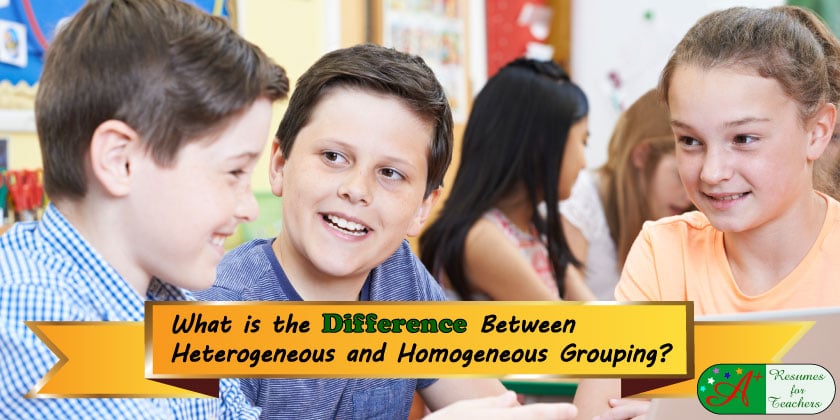Do you know what heterogeneous and homogeneous grouping are and their benefits in the classroom?
You may be asked to define these two concepts during a teacher job interview, so you must learn to answer interview questions like this one. Practicing your answers to interview questions will ensure you are prepared for your next teacher job interview.
Your response is critical, relevant to the position, and shows value to the school district.
The following information may provide you with some ideas to tailor your job interview response to homogeneous grouping or heterogeneous grouping questions.
How to Divide Students into Cooperative Learning Groups
When planning cooperative learning activities, it is necessary to divide the class into separate groups. Students will have to work together to complete the task in the groups in the groups, whatever it might be. Students will most likely need to divvy up the workload within the learning groups themselves to ensure each student in the group has a task to complete. For instance, one student can be the secretary and write down the work, one student can present the work to the class, one student can illustrate the work, and one student can check the work to make sure it is correct.
The concept of putting students into smaller groups sounds like a straight-forward task for the teacher. It’s a great way for the teacher to observe their students actively working cooperatively on a learning concept. However, the important part about grouping students includes how the teacher goes about dividing up his/her class of students to gain the best results.
Of course, we keep in mind that students are not limited to their abilities or defined by specific parameters, which is one of the big concepts of incorporating a growth mindset in the classroom.
Should you put students in heterogeneous groupings or homogeneous groupings?
Some teachers believe that students need to vary, so all learning levels are represented in each group (heterogeneous), while others believe that students should be grouped by ability level (homogeneous). There are advantages and disadvantages to both heterogeneous and homogeneous grouping. It depends on what type of activity you are running and what you want your students to do.
Take time to do some self-reflection and evaluation on past experiences with grouping students while teaching to see what worked for you. Why did it work well?
The Difference Between Heterogeneous and Homogeneous Grouping
Heterogeneous grouping is when a diverse group of students is put in the same cooperative learning group. This mixed group may consist of students of varying ages, educational levels, interests, special needs, etc. Students are of approximately the same age but function on different academic, social, and emotional levels. This method of heterogeneous grouping allows students to learn from each others’ differences and actively interact with diverse individuals while at the same time sharing their unique abilities and interests.
Homogeneous grouping is the distribution of students who function at similar academic, social, and emotional levels, being placed in the same cooperative learning group. For example, children deemed at-risk or with special needs are placed in one group, while the gifted and talented students are placed in another. Homogeneous grouping helps all students in the classroom stay on the same page as their classmates.
Pros and Cons of Heterogeneous and Homogeneous Grouping
Heterogeneous groupings are ideal for helping struggling students. However, if you want your gifted/talented students and at-grade level students to do well, homogeneous groupings tend to be more beneficial. In heterogeneous groups, students will tend to defer to the natural leaders and smartest students to lead the group and even do most of the work. However, in homogeneous groupings, new leadership structures can form, and students who never had to participate before may be forced to take on more active roles within the group.
If given a choice, students will always choose to form groups with their friends and peers (homogeneous groups) and benefit from getting to know and learn from other students in their class. If choosing to have heterogeneous groupings, divide them by having one gifted student, two average students, and one lower achieving student. This ratio of students will allow all students to benefit from the others while not making one student take on too much of the burden of work or leadership.
Are you ready for your next job interview for a teaching position? It will either make or break your chances of receiving a job offer. As the saying goes, if you fail to plan – you are planning to fail. Additional information on teacher job interview questions and answers can be found on this blog.
Our career eBook store has two popular eBooks on interviewing, one for teachers and another for school administrators. Each eBook contains 152 questions and potential responses to tough interview questions, plus tons of other resources. It’s a must-have for your next education job interview.
Review our education resume examples if you want to gain ideas or examine our resume writing quality. Learn more to find out more about Candace’s expertise as an academic resume or CV writer.


